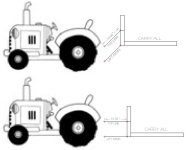beppington
Elite Member
I replied to your other post, but I didn't see this one.
How do you intend to keep your lift arms parallel? They lift by rotating, so you'll never keep them level. If it could be done, all carry-alls would be built that way. There will be a point that you have the top link attachment so low that it will bind when you try to lift, but I can't say exactly where that is.
I didn't see where he asked about keeping his lift arms level. Maybe I missed it.
Should be no need for it, though: As long as his lift arms & top link are the same length & parallel to each other, his carry all should stay level ... i.e. a parallelogram.
